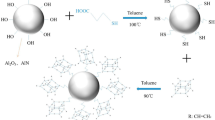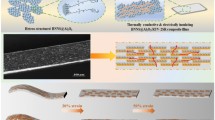Abstract
Thermally conductive and electrically insulating polymer composites are in great demand for the heat management of modern electronics. Herein, a novel method consisting of the foaming and subsequent infiltrating processes is developed to construct a thermally conductive 3D framework in silicone rubber (SR) for enhancing the thermal conductivity. The thermal conductivity of an alumina (Al2O3)/SR composite with a 3D framework (3D-Al2O3/SR) reaches 0.747 W/(m K) at 32.6 wt% Al2O3 loading, much higher than that of the corresponding Al2O3/SR composite with randomly dispersed Al2O3. This difference can be attributed to the effective thermally conductive 3D network fabricated by foaming and the strong interfacial adhesion between the framework and SR matrix. The volume electrical resistivity of the 3D-Al2O3/SR composite at 32.6 wt% Al2O3 loading is 2.12 × 1014 Ω cm, indicating its good electrical insulation. This method is facile, versatile and of low cost, which could pave the way for designing and preparing high-performance polymer composites used for heat dissipation.








Similar content being viewed by others
References
Li X, Shao L, Song N, Shi L, Ding P (2016) Enhanced thermal-conductive and anti-dripping properties of polyamide composites by 3D graphene structures at low filler content. Compos Part A 88:305–314
Zha JW, Zhu TX, Wu YH, Wang SJ, Li RKY, Dang ZM (2015) Tuning of thermal and dielectric properties for epoxy composites filled with electrospun alumina fibers and graphene nanoplatelets through hybridization. J Mater Chem C 3:7195–7202
Raza MA, Westwood A, Brown A, Hondow N, Stirling C (2011) Characterisation of graphite nanoplatelets and the physical properties of graphite nanoplatelet/silicone composites for thermal interface applications. Carbon 49:4269–4279
Chen H, Ginzburg VV, Yang J, Yang Y, Liu W, Huang Y, Du L, Chen B (2016) Thermal conductivity of polymer-based composites: fundamentals and applications. Prog Polym Sci 59:41–85
Li Z, Kong J, Ju D, Cao Z, Han L, Dong L (2017) Thermal conductivity enhancement of poly(3-hydroxylbutyrate) composites by constructing segregated structure with the aid of poly(ethylene oxide). Compos Sci Technol 149:185–191
Dai W, Yu J, Liu Z, Wang Y, Song Y, Lyu J, Bai H, Nishimura K, Jiang N (2015) Enhanced thermal conductivity and retained electrical insulation for polyimide composites with SiC nanowires grown on graphene hybrid fillers. Compos Part A 76:73–81
Zhang J, Wang X, Yu C, Li Q, Li Z, Li C, Lu H, Zhang Q, Zhao J, Hu M, Yao Y (2017) A facile method to prepare flexible boron nitride/poly(vinyl alcohol) composites with enhanced thermal conductivity. Compos Sci Technol 149:41–47
Burger N, Laachachi A, Ferriol M, Lutz M, Toniazzo V, Ruch D (2016) Review of thermal conductivity in composites: mechanisms, parameters and theory. Prog Polym Sci 61:1–28
Pang H, Xu L, Yan DX, Li ZM (2014) Conductive polymer composites with segregated structures. Prog Polym Sci 39:1908–1933
Pan G, Yao Y, Zeng X, Sun J, Hu J, Sun R, Xu JB, Wong CP (2017) Learning from natural nacre: constructing layered polymer composites with high thermal conductivity. ACS Appl Mater Interfaces 9:33001–33010
Guo Y, Xu G, Yang X, Ruan K, Ma T, Zhang Q, Gu J, Wu Y, Liu H, Guo Z (2018) Significantly enhanced and precisely modeled thermal conductivity in polyimide nanocomposites with chemically modified graphene via in situ polymerization and electrospinning-hot press technology. J Mater Chem C 6:3004–3015
Burger N, Laachachi A, Mortazavi B, Ferriol M, Lutz M, Toniazzo V, Ruch D (2015) Alignments and network of graphite fillers to improve thermal conductivity of epoxy-based composites. Int J Heat Mass Trans 89:505–513
Kim K, Ju H, Kim J (2016) Vertical particle alignment of boron nitride and silicon carbide binary filler system for thermal conductivity enhancement. Compos Sci Technol 123:99–105
Cho HB, Tokoi Y, Tanaka S, Suematsu H, Suzuki T, Jiang W, Niihara K, Nakayama T (2011) Modification of BN nanosheets and their thermal conducting properties in nanocomposite film with polysiloxane according to the orientation of BN. Compos Sci Technol 71:1046–1052
Li B, Dong S, Wu X, Wang C, Wang X, Fang J (2017) Anisotropic thermal property of magnetically oriented carbon nanotube/graphene polymer composites. Compos Sci Technol 147:52–61
Shao L, Shi L, Li X, Song N, Ding P (2016) Synergistic effect of BN and graphene nanosheets in 3D framework on the enhancement of thermally conductive properties of polymeric composites. Compos Sci Technol 135:83–91
Sun N, Zhang QP, Sun HR, Yang WB, Zhou YL, Song JF, Luo DL (2018) Enhanced thermal conductivity of 5A molecular sieve with BNs segregated structures. Adv Eng Mater 20:1700745
Li A, Zhang C, Zhang YF (2017) RGO/TPU composite with a segregated structure as thermal interface material. Compos Part A 101:108–114
Chang-Jian CW, Cho EC, Lee KC, Huang JH, Chen PY, Ho BC, Hsiao YS (2018) Thermally conductive polymeric composites incorporating 3D MWCNT/PEDOT:PSS scaffolds. Compos Part B 136:46–54
Liu S, Zhao B, Jiang L, Zhu YW, Fu XZ, Sun R, Xu JB, Wong CP (2018) Core–shell Cu@rGO hybrids filled in epoxy composites with high thermal conduction. J Mater Chem C 6:257–265
Hu M, Feng J, Ng KM (2015) Thermally conductive PP/AlN composites with a 3-D segregated structure. Compos Sci Technol 110:26–34
Jiang Y, Liu Y, Min P, Sui G (2017) BN@PPS core-shell structure particles and their 3D segregated architecture composites with high thermal conductivities. Compos Sci Technol 144:63–69
Wu K, Lei C, Huang R, Yang W, Chai S, Geng C, Chen F, Fu Q (2017) Design and preparation of a unique segregated double network with excellent thermally conductive property. ACS Appl Mater Interfaces 9:7637–7647
Zhang DL, Zha JW, Li CQ, Li WK, Wang SJ, Wen Y, Dang ZM (2017) High thermal conductivity and excellent electrical insulation performance in double-percolated three-phase polymer nanocomposites. Compos Sci Technol 144:36–42
Lin Y, Liu S, Chen S, Wei Y, Dong X, Liu L (2016) A highly stretchable and sensitive strain sensor based on graphene-elastomer composites with a novel double-interconnected network. J Mater Chem C 4:6345–6352
Yang Z, Liu H, Wu S, Tang Z, Guo B, Zhang L (2018) A green method for preparing conductive elastomer composites with interconnected graphene network via Pickering emulsion templating. Chem Eng J 342:112–119
Chen J, Huang X, Zhu Y, Jiang P (2016) Cellulose nanofiber supported 3D interconnected BN nanosheets for epoxy nanocomposites with ultrahigh thermal management capability. Adv Funct Mater 27:1604754
Zeng X, Yao Y, Gong Z, Wang F, Sun R, Xu J, Wong CP (2015) Ice-templated assembly strategy to construct 3D boron nitride nanosheet networks in polymer composites for thermal conductivity improvement. Small 11:6205–6213
Yao Y, Sun J, Zeng X, Sun R, Xu JB, Wong CP (2018) Construction of 3D skeleton for polymer composites achieving a high thermal conductivity. Small 14:1704044
Cheng JP, Liu T, Zhang J, Wang BB, Ying J, Liu F, Zhang XB (2014) Influence of phase and morphology on thermal conductivity of alumina particle/silicone rubber composites. Appl Phys A 117:1985–1992
Ren L, Li Q, Lu J, Zeng X, Sun R, Wu J, Xu JB, Wong CP (2018) Enhanced thermal conductivity for Ag-deposited alumina sphere/epoxy resin composites through manipulating interfacial thermal resistance. Compos Part A 107:561–569
Zhou W, Qi S, Tu C, Zhao H, Wang C, Kou J (2007) Effect of the particle size of Al2O3 on the properties of filled heat-conductive silicone rubber. J Appl Polym Sci 104:1312–1318
Jana P, Fierro V, Pizzi A, Celzard A (2015) Thermal conductivity improvement of composite carbon foams based on tannin-based disordered carbon matrix and graphite fillers. Mater Des 83:635–643
Carson JK, Lovatt SJ, Tanner DJ, Cleland AC (2005) Thermal conductivity bounds for isotropic, porous materials. Int J Heat Mass Trans 48:2150–2158
Ouyang Y, Hou G, Bai L, Li B, Yuan F (2018) Constructing continuous networks by branched alumina for enhanced thermal conductivity of polymer composites. Compos Sci Technol 165:307–313
Gao Z, Zhao L (2015) Effect of nano-fillers on the thermal conductivity of epoxy composites with micro-Al2O3 particles. Mater Des 66:176–182
Feng Y, He C, Wen Y, Zhou X, Xie X, Ye Y, Mai YW (2018) Multi-functional interface tailoring for enhancing thermal conductivity, flame retardancy and dynamic mechanical property of epoxy/Al2O3 composites. Compos Sci Technol 160:42–49
Fang L, Wu C, Qian R, Xie L, Yang K, Jiang P (2014) Nano–micro structure of functionalized boron nitride and aluminum oxide for epoxy composites with enhanced thermal conductivity and breakdown strength. RSC Adv 4:21010–21017
Yao Y, Zeng X, Guo K, Sun R, Jb Xu (2015) The effect of interfacial state on the thermal conductivity of functionalized Al2O3 filled glass fibers reinforced polymer composites. Compos Part A 69:49–55
Maira B, Takeuchi K, Chammingkwan P, Terano M, Taniike T (2018) Thermal conductivity of polypropylene/aluminum oxide nanocomposites prepared based on reactor granule technology. Compos Sci Technol 165:259–265
Jiang F, Cui S, Song N, Shi L, Ding P (2018) Hydrogen bond-regulated boron nitride network structures for improved thermal conductive property of polyamide-imide composites. ACS Appl Mater Interfaces 10:16812–16821
Wang X, Wu P (2018) Melamine foam-supported 3D interconnected boron nitride nanosheets network encapsulated in epoxy to achieve significant thermal conductivity enhancement at an ultralow filler loading. Chem Eng J 348:723–731
Guo Q, Luo Y, Liu J, Zhang X, Lu C (2018) A well-organized graphene nanostructure for versatile strain-sensing application constructed by a covalently bonded graphene/rubber interface. J Mater Chem C 6:2139–2147
Acknowledgements
The work is supported by National Natural Science Foundation of China (No. 51273109). The authors thank Mr. Axel Bossavit from ParisTech in France for helpful discussion.
Author information
Authors and Affiliations
Corresponding author
Ethics declarations
Conflict of interest
There are no conflicts to declare.
Additional information
Publisher's Note
Springer Nature remains neutral with regard to jurisdictional claims in published maps and institutional affiliations.
Rights and permissions
About this article
Cite this article
Song, J., Wu, L. & Zhang, Y. Thermal conductivity enhancement of alumina/silicone rubber composites through constructing a thermally conductive 3D framework. Polym. Bull. 77, 2139–2153 (2020). https://doi.org/10.1007/s00289-019-02839-3
Received:
Revised:
Accepted:
Published:
Issue Date:
DOI: https://doi.org/10.1007/s00289-019-02839-3




